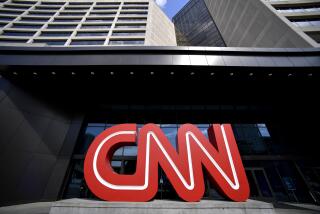Murdoch takes aim at N.Y. Times
- Share via
If the Gray Lady didn’t have enough problems battling industrywide woes, now she has Rupert Murdoch to worry about.
The media billionaire has made no secret of his desire to take aim at the New York Times once his News Corp. acquires Dow Jones & Co. and its flagship Wall Street Journal in a $5-billion deal expected to close this fall.
Murdoch said during an earnings conference call last week that he wanted the financial newspaper to have “more coverage of national, international and nonbusiness news . . . all to better compete with the New York Times and other national newspapers.”
In private, Murdoch has been more blunt.
“Rupert thinks the Times is vulnerable,” a longtime senior executive said. “He’s going to go after them.”
Like other newspapers across the country, the Times has been tightening its belt and has seen its stock price languish as readers and advertisers migrate to the Web. Nonetheless, it has fared better than other publications, retaining much of its circulation and advertising by remaining the essential newspaper of the East Coast elite.
So where does Murdoch believe the Times is vulnerable?
At a meeting early last week News Corp. executives mulled over that question but have yet to form a definitive plan.
Murdoch has publicly signaled he will beef up editorial coverage, adding four pages to the paper and hiring more staff in Europe and Asia. Murdoch also is thinking about expanding the Journal’s franchise on global financial news.
But several current and former employees said they thought Murdoch was coyly talking up what he might do to the news operation to draw attention away from his more immediate plan -- an attack on the Times’ business side.
“I would expect that he would be very aggressive on ad rates, and I would also predict that he would be very aggressive on cover price, whether it’s home delivery or newsstand,” said Ken Chandler, whose 29 years under Murdoch included stints as publisher of the New York Post and editor of the Boston Herald.
Indeed, some observers expect Murdoch to leave the newsroom more or less alone for some time.
“The biggest change will be not in editorial but in sales,” said Andrew Swinand, president of ad agency Starcom Worldwide.
Analysts see Murdoch cutting rates and the newsstand cost, which rose last month to $1.50 from $1, even though he declared during the conference call that he would not engage in “any price war.”
“I don’t want to be precise, but I can tell you that we’re certainly not going to be cutting prices of either advertising or subscriptions,” Murdoch said.
But skeptics see him doing exactly that to appeal to advertisers, and because it can be done quickly. At the New York Post, for example, he aggressively slashed prices to compete with its tabloid competitor, the New York Daily News.
“In the long term you can change your story -- you have more readers, richer readers, whatever,” said Senior Vice President Jon Swallen of ad market researcher TNS Media Intelligence. “But in the first year, while advertisers are waiting for those changes to shake out, it’s a war between sales staffs. Just because he says he will or won’t do something -- if I were the Times, I wouldn’t be basing my business strategy on that.”
Murdoch declined interview requests, as did Journal and New York Times executives.
Cutting ad rates is one thing. Changing the editorial mission of the Journal to the extent that it could knock off the Times as the authoritative paper of record is another. It would be akin to creating a soda that overtakes Coca-Cola, said Nicholas Lemann, dean of Columbia University’s journalism school.
The New York Times has “a level of ambition in the daily news report [that] is higher than anybody,” Lemann said, with more reporting depth than any other paper.
Analysts don’t see Murdoch spending wildly in the newsroom to try to become the nation’s new paper of record.
“It’s not a Post versus [New York Daily] News, where he’s clearly, clearly out to beat up the News,” a different senior News Corp. executive said. “He’s not in the mood with the New York Times, at least in the U.S.”
In addition, the Journal is already considered a first-rate production editorially. It’s “a premium product, for a premium audience, which is doing fine with premium advertising,” said Ed Atorino, an analyst with Benchmark Co. in New York.
Rather than wholesale change, Lemann said, Murdoch might move the Journal toward the Times in depth and breadth while developing a more populist voice.
That might not give the Journal the cultural power of the Times. But by focusing on half a dozen issues the editors deem thinly covered by its rival, the Journal could still help set the national agenda, Lemann said.
One clue to the future lies in Murdoch’s public musing about whether to make all or most of the Journal’s website free, junking a million subscriptions of as much as $79 per year.
Besides dealing a potentially fatal blow to mainstream efforts to charge for the news, such a move suggests that Murdoch still prizes readership and the advertisers they attract over high prices, the same choice he will face with the print edition.
Whatever his eventual strategy, Murdoch has always shown a willingness to absorb losses to build his businesses. It’s the strategy he took at the New York Post, the Times of London and the national Australian paper.
“You have to invest, and as long as he knows there will be returns eventually, he will invest,” Chandler said.
--
More to Read
Inside the business of entertainment
The Wide Shot brings you news, analysis and insights on everything from streaming wars to production — and what it all means for the future.
You may occasionally receive promotional content from the Los Angeles Times.










